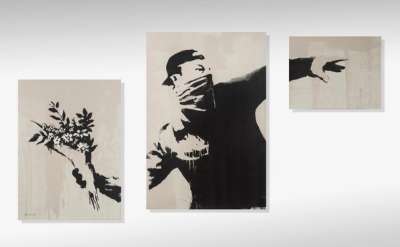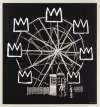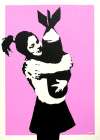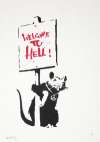Thrower
Banksy's Thrower (2019) was released in an edition of 300. It shows a man seemingly about to throw something in an act of violence, instead throwing a bunch of flowers— a symbolic appeal for peace. It adapts his earlier Love Is In The Air into a triptych across separate panels.
Banksy Thrower For sale
Thrower Value (5 Years)
Sales data across the Thrower series by Banksy varies by print. While standout works have sold at auction for up to £333883, other editions in the series remain rare to market or have yet to appear publicly for sale. Of those tracked, average selling prices have ranged from £90000 to £100000, with an annual growth rate of -31.6% across available data. Collectors should note the discrepancy in performance between more visible and lesser-seen editions when considering value potential in this series.
Thrower Market value
Auction Results
| Artwork | Auction Date | Auction House | Return to Seller | Hammer Price | Buyer Paid |
|---|---|---|---|---|---|
 Thrower (Grey) VIP Banksy Signed Print | 5 Jun 2025 | Phillips London | £76,500 | £90,000 | £130,000 |
Sell Your Art
with Us
with Us
Join Our Network of Collectors. Buy, Sell and Track Demand
Meaning & Analysis
There is perhaps no image more quintessential to Banksy's politically-charged oeuvre than Thrower. In these 2019 works, sold by Gross Domestic Product (GDP), Banksy fragmented his original Love Is In The Air (Flower Thrower) into a triptych, which focused on the torso of his iconic figure.
Over the years, Banksy has created many iterations of his Flower Thrower, which was originally created in response to the construction of the West Bank Wall separating Israel from Palestine. Banksy sprayed his original mural onto the 760km wall shortly after its extension in 2003, and it quickly became one of the most prolific Street Art stunts in history. Banksy's Flower Thrower is a young man, clad in black with a bandana covering his face, preparing to throw something in protest. In a plea for peace, Banksy replaces any potential object of violence with a bunch of coloured flowers.
In this reinvention of the Flower Thrower, Banksy split his rebel across three separate panels. Unlike his original spray painted mural, Thrower was executed with the manual printing technique of silk screen printing. As the product description on GDP explains, "This is Banksy’s first experiment with a new technique for making prints - spray the stencil onto processing film and expose the result directly onto a silk screen. This avoids photography or computer manipulation and creates a super accurate analogue representation of gestural mark making. In other words - looks pretty dope." The screen printed work is, therefore, an homage to Pop Art, as well as a nod to the stencil technique which catapulted Banksy to fame.
Sold on his experimental pop-up shop, GDP, Thrower was delivered with assembly instructions to help its owners align the panels perfectly and conserve them. At the end of this guide, Banksy left a clear and salient instruction: "Do not store indefinitely in a dark place hoping it will increase in value. This work is not intended as an investment commodity - for display purposes only." By reimagining one of his most recognisable and infamous images, Banksy therefore turned his critique to the commodification of his own artwork once again.









